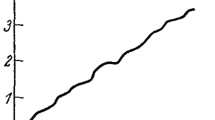Abstract
In 1983. Wigner outlined a modified Schrödinger-von-Neumann equation of motion for macroobjects, to describe their typical coupling to the environment. This equation has become a principal model of environmental decoherence which is believed responsible for the emergence of classicality in macroscopic quantum systems. Typically, this happens gradually and asymptotically after a certain characteristic decoherence time. For the Wigner function, however, one can prove that it evolves perfectly into a classical (nonnegative) phase-space distribution after a finite time of decoherence.
Similar content being viewed by others
References
E. Wigner, Phys. Rev. 40 (1932) 749.
E. Wigner, Quantum Optics, Experimental Gravitation and Measurement Theory, eds. P. Meystre and M.O. Scully, Plenum, New York, 1983, p. 43.
W. Zurek, Phys. Today 44 (1991) 36.
D. Giulini, E. Joos, C. Kiefer, J. Kupsch, I.-O. Stamatescu and H.D. Zeh, Decoherence and the Appearance of a Classical World in Quantum Theory, Springer, Berlin, 1996.
This writer’s earlier belief that the physical apparatus’ role can always be described by quantum mechanics […] implied that the “collapse of the wave function” takes place only when the observation is made by a living being — a being clearly outside of the scope of our quantum mechanics. The arguments which convinced me that quantum mechanics validity has narrower limitation, that it is not applicable to the description of the detailed behavior of macroscopic bodies, is due to D. Zeh. (1971) […]. The point is that a macroscopic body’s inner structure, i.e. its wave function, is influenced by its environment in a rather short time even if it is in intergalactic space. Hence it can not be an isolated system […]. Can an equation for the time-change of the state of the apparently not-isolated system be proposed?
H.D. Zeh, in Foundations of Quantum Mechanics, ed. B. d’Espagnat, Academic Press, New York, 1971, p. 263.
L. Diósi and C. Kiefer, J. Phys. A35 (2002) 2675.
L. Diósi, Quant. Semicl. Optics 8 (1006) 309.
E. Joos and H.D. Zeh, Z. Phys. B59 (1985) 223.
L. Diósi, Phys. Lett. A112 (1985) 288.
L. Diósi, Phys. Lett. A120 (1987) 377.
A. Peres, Quantum Theory: Concepts and Methods, Kluwer, Dordrecht, 1993.
L.A. Khalfin and B.S. Tsirelson, Found. Phys. 22 (1992) 879.
L. Diósi, Phys. Lett. A122 (1987) 221; J.J. Halliwell and A. Zoupas, Phys. Rev. A 52 (1995) 7294; 55 (1997) 4697.
Author information
Authors and Affiliations
Corresponding author
Rights and permissions
About this article
Cite this article
Diósi, L. His function and its environmental decoherence. Acta Phys. Hung. B 20, 29–34 (2004). https://doi.org/10.1556/APH.20.2004.1-2.7
Received:
Issue Date:
DOI: https://doi.org/10.1556/APH.20.2004.1-2.7




